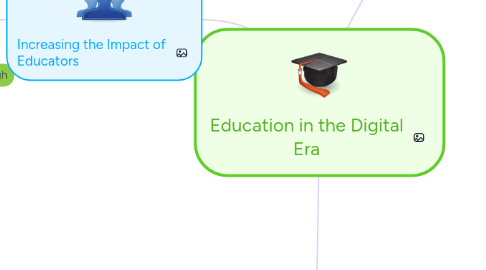
1. Increasing the Impact of Educators
1.1. Shifts in Educational Systems and Institutions
1.1.1. Create Scale for European Open Education
1.1.2. Create European Identity of Open Education
1.1.3. Use Open Education & MOOCs for specific purposes
1.1.3.1. Mass upskilling to adress skills gaps
1.2. Teacher Continuous Professional Development (CPD)
1.2.1. Create Framework to enable Innovative, Flexible, Quick, Mass Educators’ Life-Long Learning
1.2.1.1. MOOCs
1.2.1.2. Open Educational Practices
1.2.1.3. Peer-Learning
1.2.1.4. e-Competences
1.2.1.5. e-Portfolios
1.2.1.6. Open Badges
1.2.1.7. Crowd-funding
1.2.2. Utilize Teacher Communities of Practice
1.2.2.1. Peer production of OER
1.2.2.2. Peeragogy
1.2.3. Incentives for Teaching Innovation
1.2.3.1. Link Open Teaching with Research
1.3. Deep Learning Pedagogies & Personalization Methods for Technology Enhanced learning (TEL)
1.3.1. Mainstream Effective Technology-Enhanced Learning Approaches
1.3.1.1. inquiry-based learning
1.3.1.2. project-based learning
1.3.1.3. problem-based learning
1.3.1.4. quest-based learning
1.3.1.5. game-based learning
1.3.2. Personalization of Teaching and Learning
1.3.2.1. Exploit the potential of Technology to Differentiate and Personalize Learning
1.3.2.1.1. Learning Analytics
1.3.2.1.2. Big Data
1.3.3. Prerequisites
1.3.3.1. Means
1.3.3.1.1. Devices, hardware
1.3.3.1.2. Infrastructure
1.3.3.1.3. Educational Materials, Software, OER
1.3.3.1.4. Learning Environments
1.3.3.2. Competences & Support
1.3.3.3. Motivation
2. Addressing educational inequalities
2.1. Ensuring Connectivity for All
2.1.1. Infrastructure exists to facilitate connectivity
2.1.2. Do I have access to online?
2.2. Giving Access to All via Platforms
2.2.1. Personal devices
2.2.2. Shared devices in schools
2.2.3. Publicly available devices
2.2.4. Costs - low cost options?
2.3. Access to the Best Content is Possible for All
2.3.1. Open or closed?
2.3.1.1. Open Education Resources
2.3.1.1.1. Open Shakespeare
2.3.1.1.2. KlasCement
2.3.2. Costs - high or low?
2.3.3. Quality - high or low?
2.4. Every Learner Has Access to a Competent Mediator of Learning - normally a Teacher
2.4.1. Is this a mediated experience?
2.4.2. Is teacher digital literate?
2.4.3. Teacher Tools
2.4.3.1. EdPuzzle
2.5. Learner has the competence to self-direct learning through digital platform and content
2.5.1. Basic skills to access learning
2.5.2. Skills to carry out tasks in digital environments
2.5.3. Ability to use tech and digital creatively

